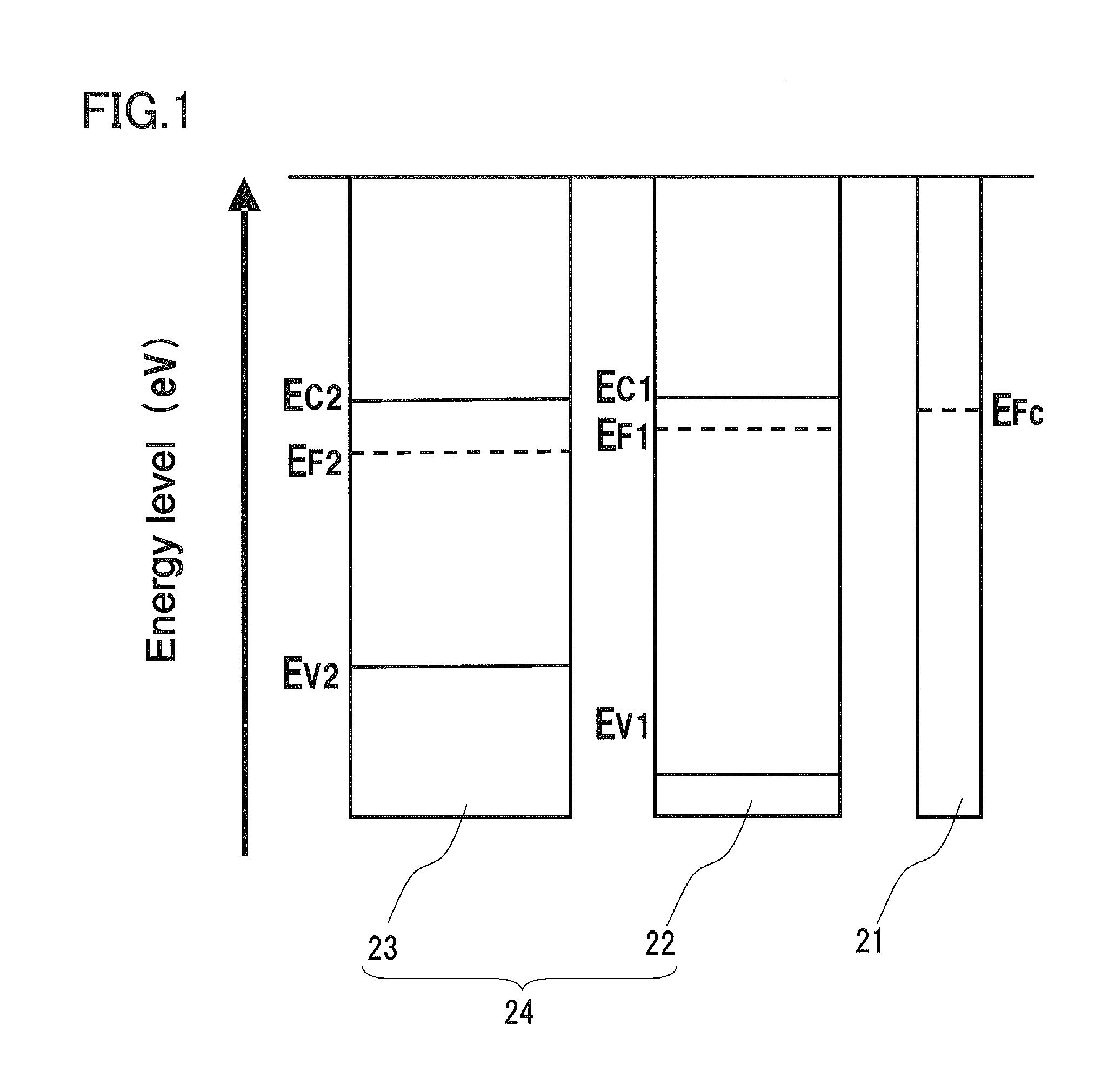Optical semiconductor, optical semiconductor electrode using same, photoelectrochemical cell, and energy system
a technology of optical semiconductor and electrode, applied in the field of optical semiconductor, optical semiconductor electrode using same, photoelectrochemical cell, energy system, can solve the problems of difficult to further reduce the band gap of insub>z, and only 1% sunlight can be used, and achieves small band gap, high quantum efficiency, and high carrier mobility
- Summary
- Abstract
- Description
- Claims
- Application Information
AI Technical Summary
Benefits of technology
Problems solved by technology
Method used
Image
Examples
first embodiment
[0035]The optical semiconductor of the first embodiment of the present invention is an optical semiconductor containing In, Ga, Zn, O and N, and has a composition in which a part of O is substituted by N in a general formula: In2xGa2(1-x)O3(ZnO)y, where x and y satisfy 0.2
[0036]The optical semiconductor having such a composition is a solid solution of InN, GaN and ZnO having a wurtzite crystalline phase, and has a crystalline phase, at least a part of which has a stable wurtzite structure. In addition, since this optical semiconductor has an In-rich composition with a high content of In, it has a smaller band gap than conventional optical semiconductors composed of a single crystal solid solution (InzGa1-zN) of GaN and InN. For these reasons, this optical semiconductor is an optical semiconductor having excellent semiconductor characteristics, and for example, it can utilize sunlight effectively and exhibit optical semiconductor properties with high quantum efficiency...
second embodiment
[0046]The optical semiconductor electrode of the present invention includes a conductive substrate and an optical semiconductor layer disposed on the conductive substrate. In the optical semiconductor layer, the junction plane near-field region of the optical semiconductor layer with the conductive substrate is composed of the composition A represented by a general formula: In2xGa2(1-x)O3(ZnO)y, where x and y satisfy 0.2<x<1 and 0.5≦y. The surface near-field region of the optical semiconductor layer is composed of the composition B having a composition in which a part of O is substituted by N in the general formula. The Fermi level of the composition A is higher than the Fermi level of the composition B. The Fermi level of the composition A and the Fermi level of the composition B can be adjusted, for example, by controlling the number of lattice defects of oxygen and nitrogen by the synthesis temperature of materials or by doping Si.
[0047]In the optical semiconductor electrode of t...
third embodiment
[0057]A photoelectrochemical cell according to an embodiment of the present invention is described.
[0058]The photoelectrochemical cell of the present embodiment includes an optical semiconductor electrode, a counter electrode, a water-containing electrolyte, and a container containing these. The optical semiconductor electrode includes a conductive substrate and an optical semiconductor layer disposed on the conductive substrate and containing the optical semiconductor of the present invention as described in the first embodiment. The counter electrode is connected electrically to the conductive substrate of the optical semiconductor electrode. The electrolyte is in contact with the surfaces of the optical semiconductor layer and the counter electrode. The photoelectrochemical cell generates hydrogen when the optical semiconductor layer is irradiated with light.
[0059]Since this configuration causes charge separation to occur in the photoexcited optical semiconductor, the quantum eff...
PUM
| Property | Measurement | Unit |
|---|---|---|
| length | aaaaa | aaaaa |
| inner diameter | aaaaa | aaaaa |
| length | aaaaa | aaaaa |
Abstract
Description
Claims
Application Information
 Login to View More
Login to View More - R&D
- Intellectual Property
- Life Sciences
- Materials
- Tech Scout
- Unparalleled Data Quality
- Higher Quality Content
- 60% Fewer Hallucinations
Browse by: Latest US Patents, China's latest patents, Technical Efficacy Thesaurus, Application Domain, Technology Topic, Popular Technical Reports.
© 2025 PatSnap. All rights reserved.Legal|Privacy policy|Modern Slavery Act Transparency Statement|Sitemap|About US| Contact US: help@patsnap.com



